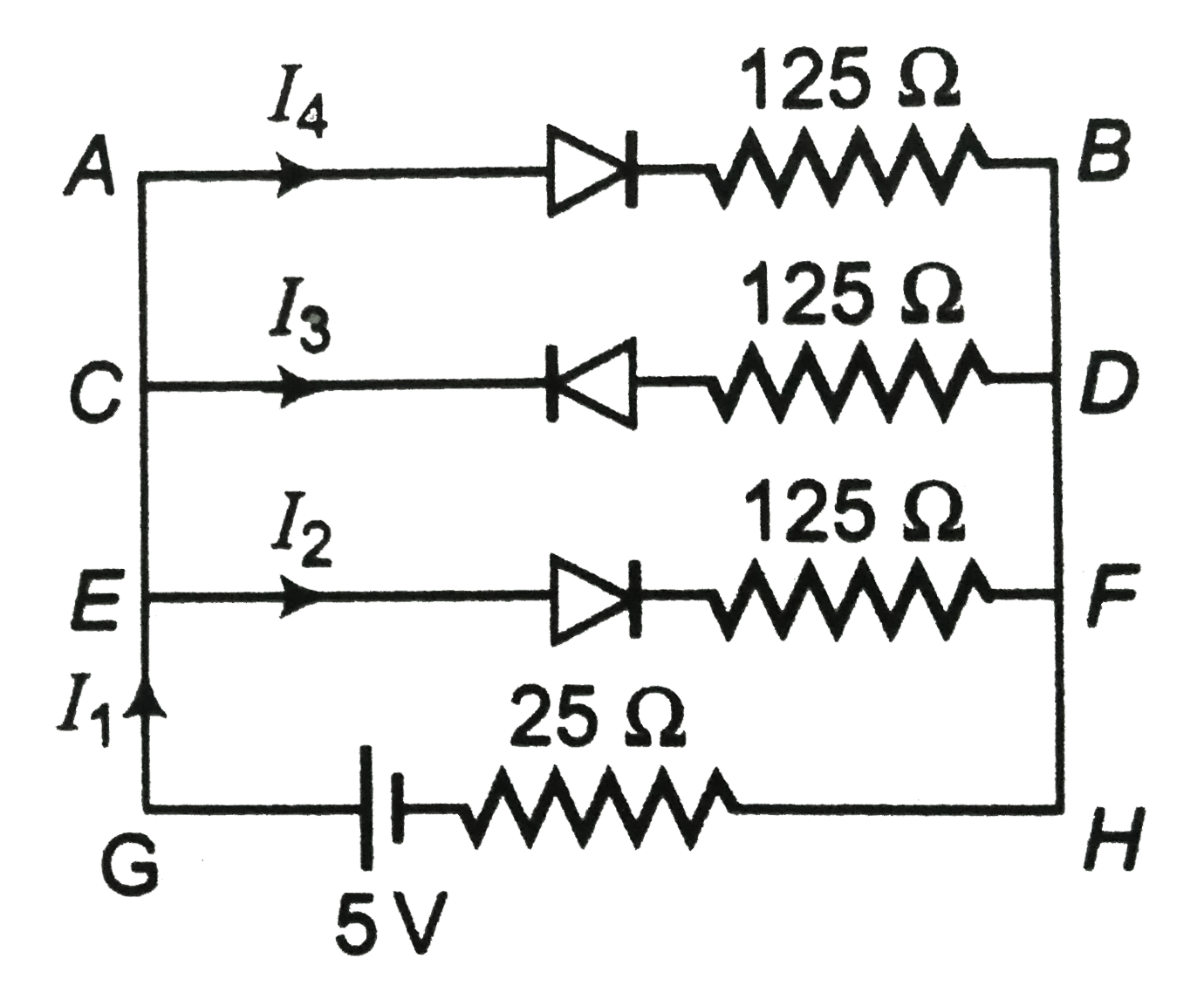In an n-p-n transistor 1010 electrons enter the emitter in 10−6s. If 2% of the electrons are lost in the base, find the current transfer ratio and the current amplification factor.
0.02
7
33
49
The correct Answer is:A
To solve the problem, we will follow these steps:
Step 1: Calculate the emitter current (IE)
The emitter current (IE) can be calculated using the formula:
IE=QT
where Q is the total charge of the electrons entering the emitter and T is the time interval.
Given:
- Number of electrons entering the emitter, nE=1010
- Charge of an electron, e=1.6×10−19 coulombs
- Time, T=10−6 seconds
First, we calculate the total charge Q:
Q=nE×e=1010×1.6×10−19
Q=1.6×10−9 coulombs
Now, substituting Q into the formula for IE:
IE=1.6×10−910−6=1.6×10−3 A=1.6 mA
Step 2: Calculate the collector current (IC)
Since 2% of the electrons are lost in the base, 98% of the electrons will reach the collector. Thus, the collector current IC can be calculated as:
IC=0.98×IE
Substituting the value of IE:
IC=0.98×1.6×10−3=1.568×10−3 A=1.568 mA
Step 3: Calculate the current transfer ratio (α)
The current transfer ratio α is defined as:
α=ICIE
Substituting the values we have:
α=1.568×10−31.6×10−3=0.98
Step 4: Calculate the current amplification factor (β)
The current amplification factor β is given by:
β=α1−α
Substituting the value of α:
β=0.981−0.98=0.980.02=49
Final Answers:
- Current transfer ratio α=0.98
- Current amplification factor β=49
The emitter current (IE) can be calculated using the formula:
IE=QT
where Q is the total charge of the electrons entering the emitter and T is the time interval.
- Number of electrons entering the emitter, nE=1010
- Charge of an electron, e=1.6×10−19 coulombs
- Time, T=10−6 seconds
Q=nE×e=1010×1.6×10−19
Q=1.6×10−9 coulombs
IE=1.6×10−910−6=1.6×10−3 A=1.6 mA
Since 2% of the electrons are lost in the base, 98% of the electrons will reach the collector. Thus, the collector current IC can be calculated as:
IC=0.98×IE
Substituting the value of IE:
IC=0.98×1.6×10−3=1.568×10−3 A=1.568 mA
The current transfer ratio α is defined as:
α=ICIE
Substituting the values we have:
α=1.568×10−31.6×10−3=0.98
The current amplification factor β is given by:
β=α1−α
Substituting the value of α:
β=0.981−0.98=0.980.02=49
- Current transfer ratio α=0.98
- Current amplification factor β=49
Topper's Solved these Questions
- SEMICONDUCTOR ELECTRONICS : MATERIALS , DEVICES AND SIMPLE CIRCUITS Book:NCERT FINGERTPS ENGLISHChapter:SEMICONDUCTOR ELECTRONICS : MATERIALS , DEVICES AND SIMPLE CIRCUITS Exercise:HOTS
Explore 8 Videos
- SEMICONDUCTOR ELECTRONICS : MATERIALS , DEVICES AND SIMPLE CIRCUITS Book:NCERT FINGERTPS ENGLISHChapter:SEMICONDUCTOR ELECTRONICS : MATERIALS , DEVICES AND SIMPLE CIRCUITS Exercise:NCERT
Explore 8 Videos
- RAY OPTICS AND OPTICAL INSTRUMENTSBook:NCERT FINGERTPS ENGLISHChapter:RAY OPTICS AND OPTICAL INSTRUMENTSExercise:NCERT Exemplar
Explore 11 Videos
- WAVE OPTICSBook:NCERT FINGERTPS ENGLISHChapter:WAVE OPTICSExercise:Assertion And Reason
Explore 15 Videos
Similar Questions
If each diode in figure has a forward bias resistance of 25 Omega and infinite resistance in reverse bias, what will be the values of the current I1,I2,I3andI4?

View SolutionThe conductivity of a semiconductor increases with increase in temperature because
View SolutionA ray of light incident at an angle θ on a refracting face of a prism emerges from the other face normally. If the angle of the prism is 5∘ and the prism is made of a material of refractive index 1.5, the angle of incidence is.
View SolutionAssertion : The frequencies of incident, reflected and refracted beam of monochromatic light are same.
Reason : The incident, reflected and refracted rays are coplanar.
View SolutionIn NPN transistor, 10^(10) electrons enters in emitter region in 10^(-6) sc. If 2% electrons are lost in base region then collector current and current amplification factor (beta) respectively are
View SolutionIn an n-p-n transistor 10^(10) electrons enter the emitter in 10^(-6) s. If 2% of the electrons are lost in the base, find the current transfer ratio and the current amplification factor.
View SolutionIn a n-p-n transistor 10^(10) electrons enter the emitter in 10^(-6)s . 2% of the elecrons are lost in the base. The current transfer ratio and the current amplification factor will be
View SolutionIn a npn transistor 1010 electrons enter the emitter in 10–6 s. 4% of the electrons are lost in the base.
The current transfer ratio will be
View SolutionIn the common emitter configuration of n-p-n transistor 1010 electrons enter the emitter in 1μs and 2% of the electrons are lost of the base. The current gain of the amplifier is
View SolutionIn an n-p-n transistor 1010 electrons enter the emitter in 10−6 s, 3% of the electrons are lost in the base. The current transfer ratio is
View SolutionIn an n-p-n transistor 1010 electrons enter the emitter in 10−6s. If 2% of the electrons are lost in the base, find the current transfer ratio and the current amplification factor.
View SolutionIn n-p-n transistor 94% of the electrons reach the colectro and 1012 electrons enter the emitter in what are the values of current transfer ratio and current amplification factor
View Solutionएक n-p-n ट्रांजिस्टर में 10−6 सेकण्ड में उत्सर्जक में 1010 इलेक्ट्रॉन प्रवेश करते हैं। आधार में 2% इलेक्ट्रॉन खो जाते हैं। धारान्तरण अनुपात की गणना कीजिए।
View SolutionIn an PNP transistor , 1010 holes enter the emitter in 10−6 s . If 2 % of holes is lost in the base , then the current amplification factor is
View Solutionn-p-n ट्रांजिस्टर में 1010 इलेक्ट्रॉन उत्सर्जक में 10−6s में प्रवेश करता है। यदि 2% इलेक्ट्रॉन आधार में खो जाते हैं, तो धारा स्थानान्तर अनुपात एवं धारा प्रवर्धन गुणांक का अनुपात क्या होगा?
View Solution
